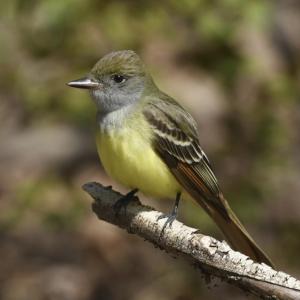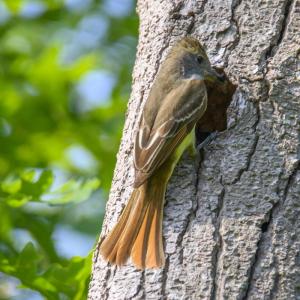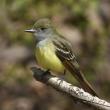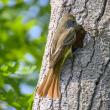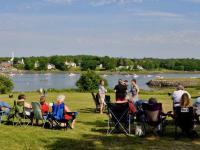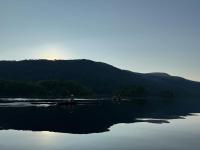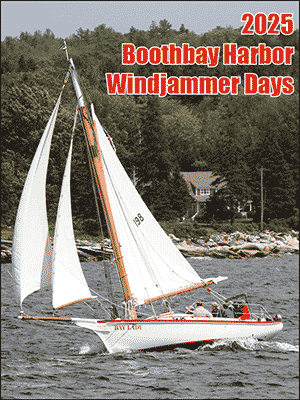The Bird that Loves Snakeskins
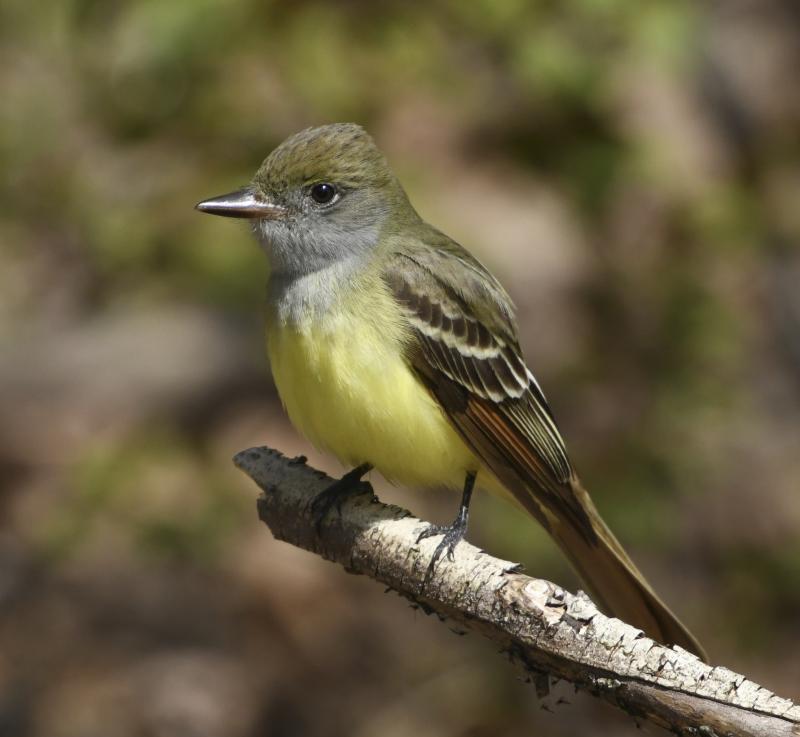 Despite the name, great crested flycatchers don't have a prominent crest. But the bright yellow belly, rufous tail, wingbars, and gray throat are distinctive. Photo by Mykola Swarnyk, courtesy of Wikimedia Commons
Despite the name, great crested flycatchers don't have a prominent crest. But the bright yellow belly, rufous tail, wingbars, and gray throat are distinctive. Photo by Mykola Swarnyk, courtesy of Wikimedia Commons
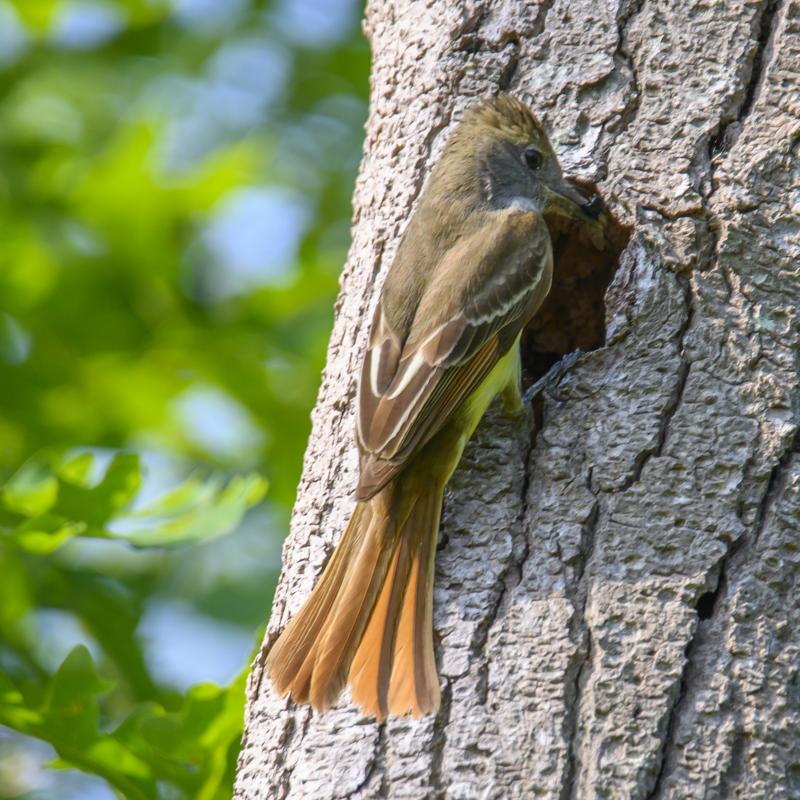 Great crested flycatchers are the only flycatcher species in eastern North America that nest in tree cavities. Photo by WolfArtist, courtesy of Wikimedia Commons
Great crested flycatchers are the only flycatcher species in eastern North America that nest in tree cavities. Photo by WolfArtist, courtesy of Wikimedia Commons
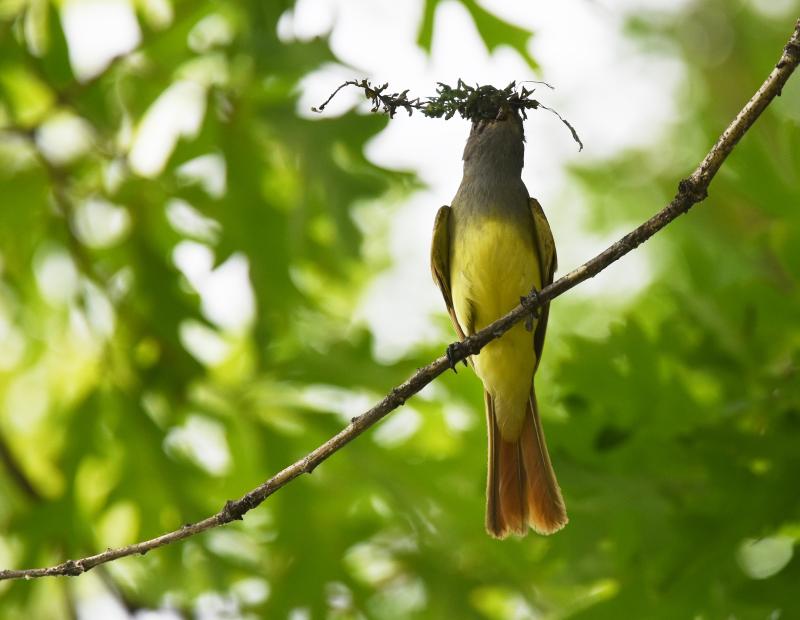 Female great crested flycatchers sometimes add lots of material into the nest cavity in order to ensure that the nest cup itself is not too deep. Photo by WildReturn, courtesy of Wikimedia Commons
Female great crested flycatchers sometimes add lots of material into the nest cavity in order to ensure that the nest cup itself is not too deep. Photo by WildReturn, courtesy of Wikimedia Commons
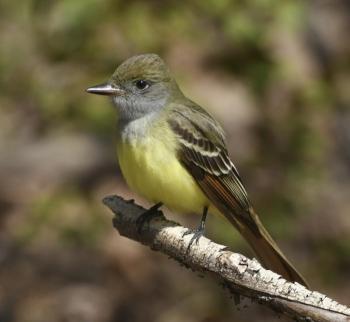 Despite the name, great crested flycatchers don't have a prominent crest. But the bright yellow belly, rufous tail, wingbars, and gray throat are distinctive. Photo by Mykola Swarnyk, courtesy of Wikimedia Commons
Despite the name, great crested flycatchers don't have a prominent crest. But the bright yellow belly, rufous tail, wingbars, and gray throat are distinctive. Photo by Mykola Swarnyk, courtesy of Wikimedia Commons
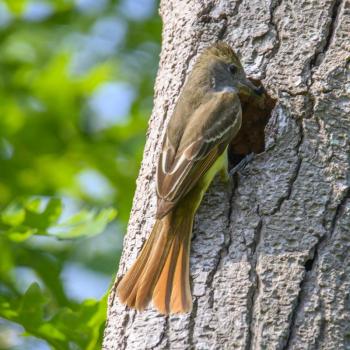 Great crested flycatchers are the only flycatcher species in eastern North America that nest in tree cavities. Photo by WolfArtist, courtesy of Wikimedia Commons
Great crested flycatchers are the only flycatcher species in eastern North America that nest in tree cavities. Photo by WolfArtist, courtesy of Wikimedia Commons
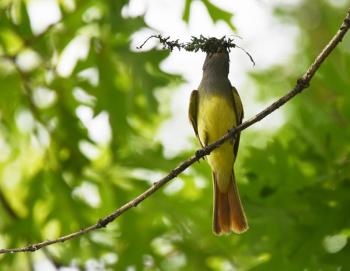 Female great crested flycatchers sometimes add lots of material into the nest cavity in order to ensure that the nest cup itself is not too deep. Photo by WildReturn, courtesy of Wikimedia Commons
Female great crested flycatchers sometimes add lots of material into the nest cavity in order to ensure that the nest cup itself is not too deep. Photo by WildReturn, courtesy of Wikimedia Commons
It’s a simple call that’s hard to ignore—a single, loud “wheeep,” or sometimes a burry “reeep.” The sound itself seems confident, brash, maybe a little raucous.
Which is why, when you search for the bird making the sound and have trouble actually seeing it, you may feel pretty frustrated. One reason that the bird making that boisterous sound—the great crested flycatcher—is hard to spot is because it is a species that prefers to stay generally within the interior of the deciduous trees and shrubs it inhabits.
But, the great crested is a flycatcher after all, so eventually one will sit out in the open and give you a good luck. When it does, you will see a fairly large bird, close to but a little slimmer than a blue jay, with a bright lemon-yellow belly contrasting with a gray throat. With a little more observation you’ll notice its rufous tail. Despite its name, you won’t notice much of a crest.
It’s a striking bird, we think you’ll agree.
Great crested flycatchers are found in shrubby, second-growth forests of oaks, maples, beech but not in areas dominated by coniferous trees like spruce, hemlock, balsam fir, or pine. On Maine’s coastal peninsulas, the farther south you, the less likely you are to see them since the cool ocean waters favor more spruce and balsam fir. Great crested flycatchers also get more scarce when you get over into more spruce -and fir-dominated landscapes of northwestern Maine as well as the eastern part of the state. They reach the northeastern limit of their breeding range less than a hundred miles north of the Maine border along the southern shore of the St. Lawrence in Quebec.
Great crested flycatchers are unique among the flycatchers in the eastern U.S. and Canada in that they build their nests inside tree cavities. They don’t have the bills for making a cavity themselves so they are reliant on cavities excavated by woodpeckers, finding natural cavities, or using nest boxes. While cavity nesting seems like an unusual life history feature for a flycatcher, there are other flycatchers in other parts of North America and the world that nest in cavities. This includes a number of close relatives of the great crested flycatcher like the ash-throated flycatcher and brown-crested flycatcher.
The female great crested flycatcher is thought to do most of the work to build the nest cup within the cavity. If it’s too deep she will add to the bottom of it to raise it closer to the hole. One study of a European cavity-nesting flycatcher surmised that the birds may avoid nest cavities that are too deep for the simple reason that they are too dark for them to see what’s going on!
One other cool aspect of the nest building behavior of great crested flycatchers is that they often put shed snakeskins in the nests, sometimes with the skins hanging out the nest hole.
Why?
To find out, one research group set up artificial nests in boxes with quail eggs. Half the nest boxes had snake skins in the fake nests and half did not. The difference was striking. Nest boxes with snake skins had half as much loss of eggs from predators as those without snake skins.
We are hoping that the great crested flycatcher that we heard in our backyard today will be staying around for the summer so we can see, first-hand, some of its unique attributes and behaviors.
Jeffrey V. Wells, Ph.D., is a Fellow of the Cornell Lab of Ornithology and Vice President of Boreal Conservation for National Audubon. Dr. Wells is one of the nation's leading bird experts and conservation biologists. He is a coauthor of the seminal “Birds of Maine” book and author of the “Birder’s Conservation Handbook.” His grandfather, the late John Chase, was a columnist for the Boothbay Register for many years. Allison Childs Wells, formerly of the Cornell Lab of Ornithology, is a senior director at the Natural Resources Council of Maine, a nonprofit membership organization working statewide to protect the nature of Maine. Both are widely published natural history writers and are the authors of the popular books, “Maine’s Favorite Birds” (Down East Books) and “Birds of Aruba, Bonaire, and Curaçao: A Site and Field Guide,” (Cornell University Press).

